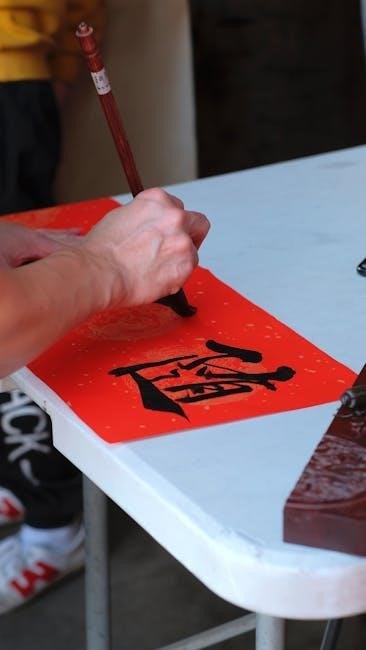instruction manual crockpot symbols uk
effectively every time always.
Understanding the Basics of Crockpot Symbols
Understanding the basics of Crockpot symbols is crucial for effective use of the slow cooker, as outlined in the instruction manual. The manual provides a comprehensive guide to deciphering the symbols, including the low, high, and warm settings. By familiarizing themselves with these symbols, users can unlock the full potential of their Crockpot. The symbols are typically represented by wavy lines, with two lines indicating the low heat setting and three lines indicating the high heat setting. Additionally, the manual explains the importance of proper usage and maintenance to ensure optimal performance and safety. Users can find detailed information on the symbols and their meanings in the Crockpot instruction manual, which is an essential resource for anyone looking to get the most out of their slow cooker. This knowledge is essential for beginners and experienced users alike.

Crockpot Temperature Ranges
Crockpot temperature ranges vary, with low and high settings, using the manual for guidance always helps to achieve perfect results every time with ease and convenience.
General Temperature Guidelines for Crockpot Owners
General temperature guidelines for Crockpot owners are crucial for safe and effective use of their slow cookers. The instruction manual provides detailed information on temperature ranges and settings. Crockpot owners should familiarize themselves with the different temperature settings, including low, high, and warm. Understanding these settings is essential for achieving perfect results and preventing overcooking or undercooking. The manual also provides guidance on how to use the temperature settings for various types of food, including meats, vegetables, and soups. By following the general temperature guidelines outlined in the manual, Crockpot owners can ensure that their meals are cooked to perfection every time. Additionally, the manual offers tips and advice on how to adjust the temperature settings to suit individual preferences and recipes. This information is essential for getting the most out of your Crockpot.

Crockpot Settings and Symbols
Crockpot settings and symbols are explained in the manual with detailed descriptions and illustrations for easy understanding always online.
Deciphering Common Crockpot Symbols and Settings
To decipher common crockpot symbols and settings, users can refer to the instruction manual, which provides a detailed guide on the various symbols and their meanings, including the low, high, and warm settings. The manual also explains the different buttons and dials on the control panel, making it easier for users to navigate and understand their crockpot. By familiarizing themselves with the common symbols and settings, users can unlock the full potential of their crockpot and explore a wide range of recipes and cooking options. The instruction manual is a valuable resource that can help users to get the most out of their crockpot, and it is recommended that users read and keep the manual for future reference, as it contains important information on safety, maintenance, and troubleshooting. This information is essential for users to use their crockpot safely and effectively.
Crockpot Models and Variations
Crockpot models vary, with different sizes and features, including digital and manual controls, available in the UK market always and every time effectively.
Exploring Differences in Crockpot Models and Symbols
Exploring the differences in Crockpot models and symbols is crucial for users to understand their slow cooker’s unique features and settings, using the instruction manual as a guide. The various models available in the UK market have distinct symbols and controls, which can be confusing for new users. However, by familiarizing themselves with these differences, users can unlock their Crockpot’s full potential and cook a wide range of delicious meals. The manual provides detailed information on the different models and their corresponding symbols, making it an essential resource for Crockpot owners. With this knowledge, users can confidently navigate their slow cooker’s settings and achieve perfect results every time, whether they are cooking for themselves or for a large group of people, and get the most out of their Crockpot.

Troubleshooting Crockpot Issues
Troubleshooting Crockpot issues requires consulting the manual and understanding common problems and solutions always effectively online every time using resources.
Resources for Interpreting Crockpot Symbols and Troubleshooting
Resources for interpreting Crockpot symbols and troubleshooting are available online, including the official Crockpot website and instruction manuals. These resources provide detailed information on Crockpot symbols, settings, and troubleshooting guides. Additionally, online forums and communities offer a platform for users to share their experiences and solutions to common problems. The Crockpot customer support team is also available to assist with any queries or concerns. By utilizing these resources, users can effectively troubleshoot and resolve issues with their Crockpot, ensuring optimal performance and safety. Furthermore, the resources provide tips and guidelines for maintenance and care, helping to extend the lifespan of the Crockpot. Overall, the resources available for interpreting Crockpot symbols and troubleshooting are comprehensive and easily accessible, making it easier for users to get the most out of their slow cooker.
Crockpot Instruction Manual UK
The provides essential guidance on using and maintaining the slow cooker, including symbols and settings explanations always effectively online.
Importance of Reading and Keeping Crockpot Instructions
Reading and keeping the Crockpot instructions is crucial for optimal performance and safety, the manual provides valuable information on usage, maintenance, and troubleshooting, helping users to avoid common mistakes and ensure their slow cooker lasts longer. By following the guidelines outlined in the manual, users can prevent accidents, such as electrical shocks or fires, and also learn how to properly clean and store their Crockpot. The instructions also include important safety precautions, such as keeping the slow cooker out of reach of children and pets, and avoiding overheating. Additionally, the manual provides tips on how to get the most out of the Crockpot, including recipes and cooking techniques, making it an essential resource for anyone who wants to get the best results from their slow cooker. The manual is available online for easy access.

Crockpot Control Panels and Symbols
Crockpot control panels feature various symbols and settings, including temperature controls and cooking modes, for easy navigation and optimal cooking results always using the manual.
Understanding Control Panels with Symbols and Descriptions
The control panel on a Crockpot features a range of symbols and descriptions to help users navigate the different settings and options. By referring to the instruction manual, users can gain a better understanding of the various symbols and descriptions, including the temperature controls, cooking modes, and timer settings. The control panel typically includes a series of buttons or dials that allow users to select the desired cooking time and temperature, as well as other options such as delayed start or keep warm. Understanding the control panel and its symbols is essential for getting the most out of a Crockpot and ensuring that meals are cooked to perfection. With a little practice, users can become familiar with the control panel and start experimenting with new recipes and cooking techniques, using the manual as a guide always.





